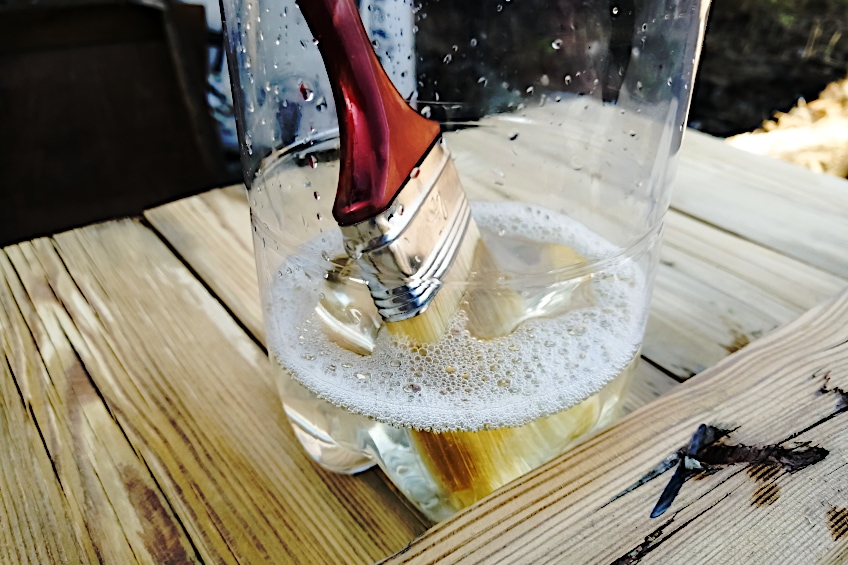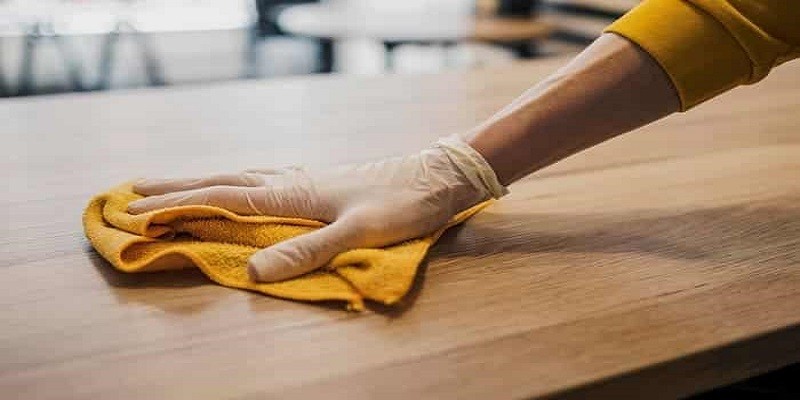Last Updated on September 11, 2023
To clean polyurethane, use a mild soap and water solution. In a small bucket, mix a few drops of liquid dish soap with warm water until suds form.
Wet a soft cloth with the soapy water and gently wipe down the polyurethane surface, removing any dirt or grime. Rinse the cloth frequently and avoid using excessive water to prevent damage to the polyurethane. Dry the surface thoroughly with a clean cloth.
Take care to avoid abrasive cleaners or scrub brushes, which can scratch or damage the polyurethane finish. Regular cleaning will help maintain the appearance and longevity of your polyurethane surfaces.

Credit: resin-expert.com
Polyurethane Surfaces
Polyurethane surfaces can be effectively cleaned by using mild soap and water. Avoid harsh chemical cleaners to prevent damage. Gentle scrubbing with a soft cloth or sponge can remove dirt and stains, leaving the surface looking clean and well-maintained.
Polyurethane is a versatile material commonly used for various surfaces, including floors, furniture, and coatings. Understanding the different types and properties of polyurethane surfaces is essential for effective cleaning and maintenance. Let’s explore the key aspects below:
Types Of Polyurethane Surfaces
Polyurethane surfaces come in different forms, each with specific characteristics and purposes. Here are the main types you may encounter:
- Polyurethane-coated surfaces: These surfaces have a layer of polyurethane applied as a protective coating. They are commonly found in furniture pieces such as tables, chairs, and cabinets.
- Polyurethane foam: Used in mattresses, seat cushions, and other upholstered items, polyurethane foam provides comfort and support.
- Polyurethane finishes: Applied as a topcoat, polyurethane finishes enhance the durability and aesthetics of wood floors and other wooden surfaces.
Properties Of Polyurethane Surfaces
Understanding the properties of polyurethane surfaces enables us to approach their cleaning and maintenance correctly. Here are the essential properties to consider:
- Durability: Polyurethane surfaces are known for their exceptional durability, making them able to withstand regular use and wear.
- Water resistance: Most polyurethane surfaces exhibit water-resistant properties, protecting them from liquid spills and moisture damage.
- Chemical resistance: Polyurethane surfaces are generally resistant to common household chemicals, reducing the risk of staining or degradation.
- Scratch resistance: A notable attribute of polyurethane surfaces is their ability to resist scratches, maintaining their visual appeal over time.
- Easy maintenance: Polyurethane surfaces are relatively easy to maintain, requiring simple everyday cleaning routines to keep them in good condition.
By understanding the different types and properties of polyurethane surfaces, you’ll be better equipped to tackle their cleaning and maintenance needs effectively. Let’s explore the cleaning techniques and tips in the upcoming sections.
Essential Cleaning Tools And Materials
To clean polyurethane effectively, you’ll need essential cleaning tools and materials. Ensure you have a soft microfiber cloth and a mild, non-abrasive cleaner specifically designed for polyurethane surfaces. Gently wipe the surface with the cloth and cleaner to remove any dirt or stains, then rinse with water and pat dry.
Polyurethane is a versatile and durable material commonly used in the manufacturing of furniture, flooring, and other household items. However, like any other surface in your home, it requires regular cleaning and maintenance to extend its lifespan and keep it looking its best.
In this blog post, we will guide you through the process of cleaning polyurethane, providing you with essential tips, tools, and materials to ensure a thorough and effective cleaning routine.
Selecting The Right Cleaning Tools:
- Soft-bristle brush: A soft-bristle brush is ideal for gently removing dust and debris from the polyurethane surface without causing any scratches or damage.
- Microfiber cloth: Microfiber cloths are excellent for wiping down polyurethane surfaces as they are gentle, lint-free, and can effectively remove smudges and fingerprints.
- Vacuum cleaner with a soft brush attachment: This tool can be used to remove loose dirt and debris from hard-to-reach areas, such as crevices or edges.
- Soft sponge or mop: To clean larger areas, you can use a soft sponge or mop dampened with the appropriate cleaning solution. Make sure to wring out excess liquid to avoid oversaturating the polyurethane surface.
- Toothbrush or soft toothpick: These tools are useful for cleaning tight corners or removing stubborn grime that may accumulate over time.
Choosing Appropriate Cleaning Materials:
- Mild soap or detergent: Opt for a mild soap or detergent that is specifically formulated for use on delicate surfaces. Harsh chemicals can damage the polyurethane coating, so it is best to avoid abrasive cleaners or solvents.
- Warm water: Mix warm water with the mild soap or detergent to create a gentle cleaning solution. Hot water should be avoided as it can cause the polyurethane to warp or lose its protective coating.
- White vinegar: For tougher stains or sticky residue, you can create a cleaning solution using equal parts white vinegar and warm water. Vinegar is a natural and safe alternative to harsh chemicals and can effectively dissolve grime.
- Isopropyl alcohol: Isopropyl alcohol can be used to remove stubborn stains, such as ink or marker, from polyurethane surfaces. Apply a small amount to a clean cloth and gently rub the affected area until the stain is lifted.
- Avoid using wax-based cleaners or polishes: These products can leave a greasy residue on polyurethane surfaces and may cause them to become slippery.
Remember, when using any cleaning solution or material, it is essential to test a small, inconspicuous area first to ensure that it does not damage or discolor the polyurethane.
Cleaning polyurethane surfaces is a straightforward task when armed with the right tools and materials. By selecting the appropriate cleaning tools and materials, you can effectively remove dirt, grime, and stains without compromising the integrity of the polyurethane coating. Regular maintenance and cleaning will not only keep your polyurethane items looking their best but also help prolong their lifespan.
Step-By-Step Cleaning Process
Discover the step-by-step cleaning process for effectively cleaning polyurethane surfaces. From prepping the area to using the right cleaning solutions, this guide will ensure a thorough and efficient cleaning routine for your polyurethane items.
Preparing The Polyurethane Surface:
- Remove any loose items from the surface, such as decor or accessories.
- Clear the area to ensure ample space for cleaning.
- Carefully inspect the surface for any major stains or spills that may require special treatment.
- Gather all the necessary cleaning supplies to have them ready for use.
Removing Dust And Debris:
- Start by using a soft microfiber cloth or feather duster to gently remove loose dust and dirt from the polyurethane surface.
- For smaller crevices or hard-to-reach areas, use a soft-bristle brush or a can of compressed air to dislodge any embedded debris.
- To further ensure a clean surface, vacuum the area with a soft brush attachment to capture any remaining particles.
Treating Stains And Spills:
- For tough stains or spills, prepare a mild cleaning solution by mixing warm water with a few drops of gentle dish soap.
- Dip a clean cloth or sponge into the solution and wring out any excess liquid.
- Gently blot the stained area, avoiding vigorous rubbing which may damage the polyurethane surface.
- If the stain persists, use a specialized polyurethane cleaner or a mixture of equal parts vinegar and water for extra cleaning power. Follow the product instructions carefully.
Gentle Cleaning Techniques:
- Regularly dust the polyurethane surface using a soft microfiber cloth or feather duster to prevent the buildup of debris.
- Avoid using abrasive cleaners, harsh chemicals, or rough scrub brushes as they can cause damage to the polyurethane finish.
- To maintain the sheen of the surface, periodically apply a thin coat of polyurethane polish or a specifically formulated furniture wax.
- Wipe spills and water immediately to prevent staining or damage to the polyurethane finish.
By following these step-by-step cleaning processes, you can effectively clean and maintain your polyurethane surface, keeping it looking its best for years to come.
Maintenance Tips For Long-Term Durability
To ensure the long-term durability of your polyurethane surface, it is essential to properly clean it. By following these maintenance tips, you can keep your polyurethane looking its best and ensure its longevity.
Polyurethane is a popular and durable finish that is commonly used on hardwood floors, furniture, and other wood surfaces. To ensure that your polyurethane stays in great condition and maintains its durability for the long haul, follow these helpful maintenance tips:
Preventing Scratches And Damages:
- Use furniture pads or felt pads on the bottom of your furniture to prevent scratches when moving them.
- Avoid dragging heavy objects across polyurethane surfaces as this can cause scratches. Instead, lift the object and place it carefully.
- Consider using area rugs or floor runners in high-traffic areas to provide an extra layer of protection against scratches.
- Trim your pet’s nails regularly to prevent them from scratching the polyurethane surface.
Applying Protective Coatings:
- Apply a protective coating, such as a wax or polish, every few months to provide an additional layer of protection to the polyurethane surface. This will help maintain its shine and prevent wear and tear.
- Before applying any new protective coating, make sure to clean the surface thoroughly to remove any dirt or debris that could hinder the adhesion of the new coating.
Regular Cleaning And Maintenance Schedule:
- Dust and sweep the polyurethane surface regularly using a soft-bristle broom or a microfiber mop. This will help remove any loose dirt or debris that can cause scratches.
- Use a damp cloth or mop with a mild cleaning solution to wipe away stains or spills promptly. Avoid using harsh chemicals or abrasives as they can damage the polyurethane finish.
- Avoid excessive moisture on the polyurethane surface as it can cause damage and discoloration. If necessary, use a humidifier to maintain optimal levels of humidity.
- Place doormats at entryways to reduce the amount of dirt and grit that can be tracked onto your polyurethane floors.
By following these maintenance tips, you can keep your polyurethane surfaces looking clean and maintaining their durability for years to come. Remember to take preventative measures to avoid scratches and damages, apply protective coatings periodically, and establish a regular cleaning schedule to keep your polyurethane in top shape.
Frequently Asked Questions On How To Clean Polyurethane?
How Do You Clean Polyurethane Surfaces?
To clean polyurethane surfaces, wipe with a damp cloth and mild soap solution, avoiding abrasive cleaners.
Can You Use Vinegar To Clean Polyurethane?
Yes, you can mix equal parts vinegar and water to create a gentle cleaning solution for polyurethane surfaces.
What Should You Avoid When Cleaning Polyurethane?
Avoid using abrasive sponges, scouring pads, or harsh chemicals, as they can damage the polyurethane finish.
How Often Should You Clean Polyurethane Surfaces?
It is recommended to clean polyurethane surfaces regularly to prevent the build-up of dirt and grime, ideally once a week.
How Do You Maintain The Shine Of Polyurethane Surfaces?
To maintain the shine of polyurethane surfaces, use a silicone-based cleaner and avoid excessive exposure to sunlight.
Conclusion
Keeping your polyurethane clean is essential to maintain its shine and protect its surface. By following these simple steps, you can easily keep your polyurethane looking brand new. Regular dusting with a microfiber cloth will help remove any loose dirt and debris.
Avoid using harsh chemicals or abrasive cleaners that can damage the surface. Instead, opt for a mild soap and water solution or a specialized polyurethane cleaner. Gently scrub the surface using a soft cloth or sponge, making sure to rinse thoroughly.
Finally, dry the surface completely to prevent water spots. Remember to regularly inspect your polyurethane for any signs of wear or damage and address them promptly. With proper care and maintenance, your polyurethane will continue to add beauty and elegance to your space for years to come.




